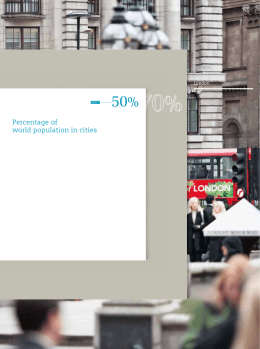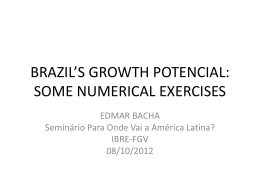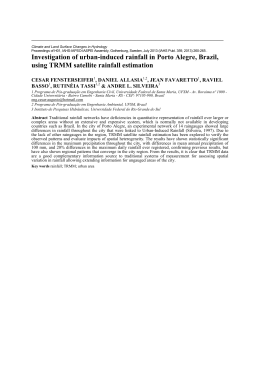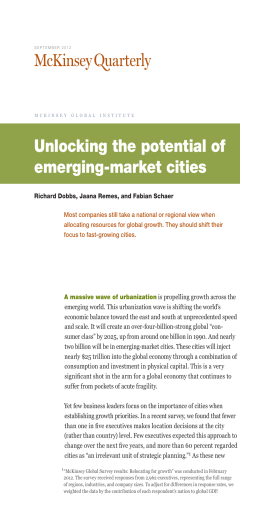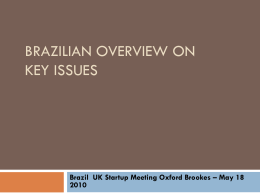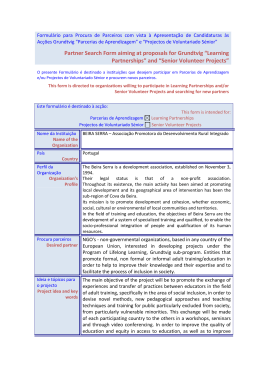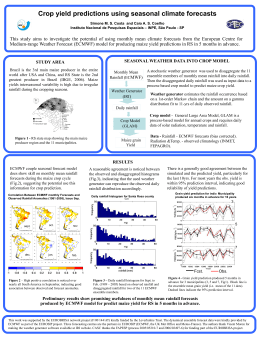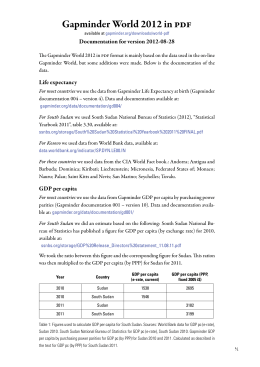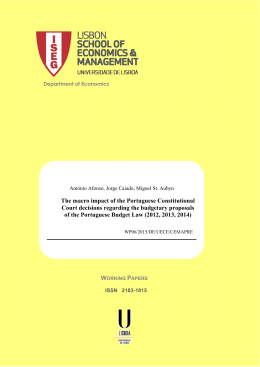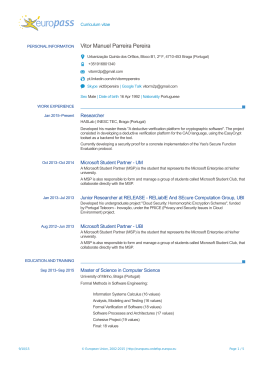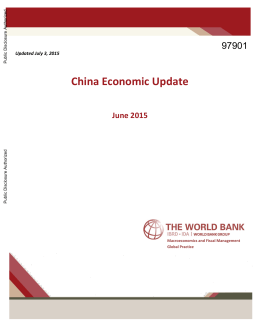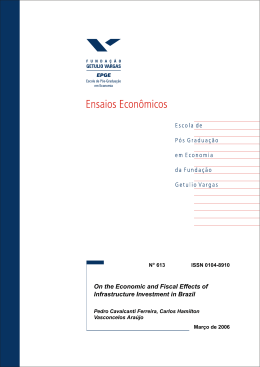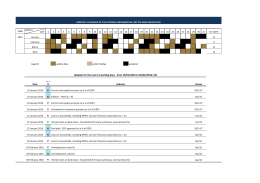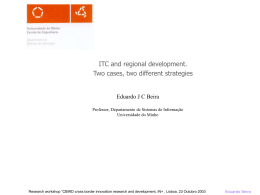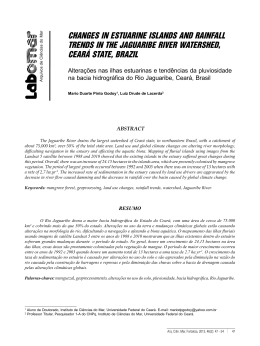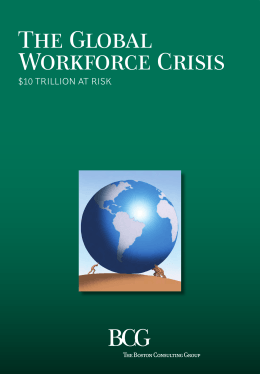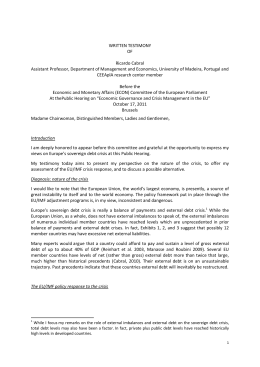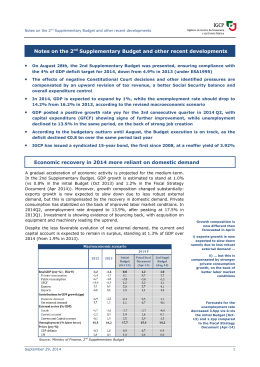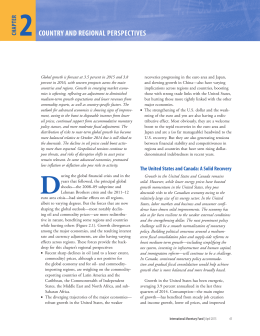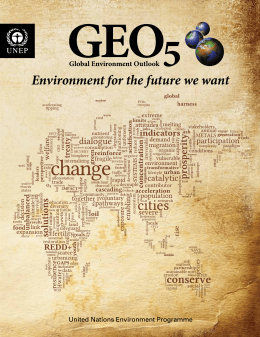Gulbenkian Think Tank on Water and the Future of Mankind Water and Food Security for 9 billion in 2050 - Doubling production or 100% access? December 6, 2010 Jan Lundqvist Senior scientific advisor Issues & messages • Food security not about production • No such thing as an average climate • Purchasing power >> demography Changes in Food Supply, 1961 – 2005 Between 2007 – 2008, world food supply increased by 5% (a new record) Parallel with this, the number of undernourished increased by 150 million Mr Henry Kissinger at First World Food Summit, 1974: (then Secretary of State, USA) ”No child will go to bed hungry within ten years” Dramatic Jump in Undernourishment while Supply increased Undernourishment & overeating 1,000 million undernourished - numbers increasing? 1,400 million overweight, 400 million obese – numbers increasing (Source: Economist, Dec. 13, 2003; S. Brichieri-Colombi, WWW 2006) World Population Water Withdrawals Population: Withdrawals: 1900: 1.65 billion 2000: 6 billion 1900: 700 km3 2000: 3.500 km3 Increase in GDP/purchasing power – fine! Source: Lundqvist et al. 2007 • Shift to water intensive diets with GDP growth • Intensified resource pressure and environmental risks • Many food items susceptical to degradation/waste Socio-economic trends; Food supply, water & environmental cost Food supply in China, 1961 - 2005 Water footprint Source: Junguo Liu & Hub Savenije World Food Summit (2009): increase food production by 70% by 2050 Intensified resource use; nutrients, chemicals, energy, etc. Water bubbles are the real thing: “…we have enjoyed a series of water „bubbles‟ to support economic growth over the past 50 years or so….. We are now on the verge of water bankruptcy in many places with no way of paying the debt back”. World Economic Forum, January 2009 What about demography & GDP? Demographic and GDP Trends Population (billion) 1800: (T. R. Malthus) Urban (billion) <1 1900: 1.65 1950: just after WW2 2.5 2000: 6 2050: GDP ($ billion; 2005 ppp) 913 (1820) 7,006 3 56,593 ~9 ~ 6.5 193,318*) 50% 125% 400% (2005) *) trend projection Increase: (2000 -2050) Source: GDP trend projection: Hillebrand, E., 2009. Another 2+ billion in a generation - with dreams - want/demand/right to sense development Population below & above poverty line, 2005 Source: Shah, 2010 What about water? Additional storage peaked in the 70s Reservoirs (number per year) 80 70 60 50 40 30 Other regions Asia Europe North America 20 10 0 Up to 1900 1901-1950 1951-1960 1961-1970 1971-1980 1981-1990 1991-1998 Source: Mats Lannerstad Rainfall: Significant Uncertainty and Risk Variability of rainfall – Beira, 1908 to 2009 400 BEIRA: monthly rainfall 1908 to 2009 350 300 250 200 150 100 50 0 Jan Feb 1908 1919 1930 1941 1952 1963 1974 1985 1996 Mar 1909 1920 1931 1942 1953 1964 1975 1986 1997 Apr 1910 1921 1932 1943 1954 1965 1976 1987 1998 May 1911 1922 1933 1944 1955 1966 1977 1988 1999 Jun 1912 1923 1934 1945 1956 1967 1978 1989 2000 Jul 1913 1924 1935 1946 1957 1968 1979 1990 2001 Aug 1914 1925 1936 1947 1958 1969 1980 1991 2002 Sep 1915 1926 1937 1948 1959 1970 1981 1992 2003 Oct 1916 1927 1938 1949 1960 1971 1982 1993 2004 Nov 1917 1928 1939 1950 1961 1972 1983 1994 2005 Dec 1918 1929 1940 1951 1962 1973 1984 1995 2006 Source: JeanMarc Faures, FAO The seven lean and the seven fat years (Zimbabwe, 1910 – 2000) Possibilities for high yield High risk; low yield For the Farmer and Dam/Reservoir Operator ’There is no Such Thing as an Average’ Bhavani Basin & Dam ”Dams as Modern Temples of India” Source: Mats Lannerstad, Linköping University Rainfed Agriculture; Soil moisture/green water: size & management Unpredictable & variable precipitation + Global warming; Rapid return flow Options for Food & Livelihood Security Land use that permits infiltration of rainwater; soil moisture = green water resource • Storing water • Storing food • Market access Soil moisture enough to overcome effects of dry spells? Perspectives on the future Plan A: Food production to increase by 70% by 2050 World Food Summit, Rome, November 2009. Plan B: Post-harvest logistics; food/agr. produce; Similar: World Bank (2008), N. Borlaug (2002), etc. - storage, transport & market access Climate change may reduce potential yields in SSA and SA by 30% by 2030 (Lobell et al. 2008 in Science) Attention to use & food intake; - Check definition on food security Temperature increase may reduce yields of corn, soya beans and cotton by 30 – 46% in the US in a century (Schlenker & Roberts, PNAS, 2009) ”112 pounds of food wastage per month for a family of four” (NYT, May 18, 2008) Food Security … ” …exists when all people, at all times, have physical and economic access to sufficient , safe and nutritious food to meet their dietary needs and food preferences for an active and healthy life” Rome Declaration (FAO, 1996) - How much is ”sufficient”? 2,000 – 2,200 kcal/person, day on average - What to do when preferences deviate from ”sufficient”? Food supply & food intake requirement Average intake requirement: 1,800 – 2,200 kcal/p, d CONCLUSIONS • Poverty major constraint to water & food access • Affluence associated with high water pressure • Beware of statistical averages • Attention to food chain efficiency Where is the road ahead?
Download
